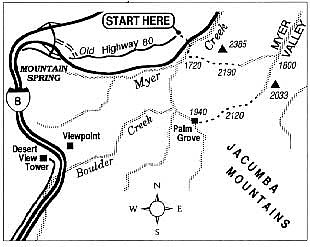 Facebook
Facebook
 X
X
 Instagram
Instagram
 TikTok
TikTok
 Youtube
Youtube
Have you ever driven down Interstate 8 east of Jacumba and, eyeing the immense boulder piles that rise on both sides, wondered what it would be like to clamber over them? Here's your chance. Follow these directions, and you'll be on your way into what is known as the Jacumba Wilderness. This rugged and picturesque high-desert area gets relatively few footprints from recreational hikers and quite a number of them from migrants heading north from Mexico. So -- a word to the wise -- it is better to travel in large groups. Also bear in mind that by May the desert heat may reach an oppressive level on some days.
Exit I-8 at Mountain Spring. At a point midway in the "island" between the eastbound and westbound lanes of the freeway, turn east on a rough dirt road. In 0.2 mile this road joins the abandoned concrete ribbon of old US Highway 80. Drive (or walk if the road is too rough) east for an additional 1.3 miles and park near the road's end -- just before the brink of a road cut made for the eastbound lanes of I-8. What lies ahead is a 4-mile loop hike, or a shorter or longer reconnaissance of the area according to your taste. Knowledgeable hikers will want to have a copy of the US Geological Survey 7.5-minute In-Ko-Pah Gorge topographic map with them.
Scramble down the slope about 100 feet to the sandy bed of Myer Creek. Pass under the lanes of I-8 through the large culvert to the west and continue 0.1 mile in the wash until you come to the base of a rocky gully on the left (east). Scramble up the coarse-grained granitic boulders in this gully; after 400 feet of elevation gain you join a sandy wash. Continue east, passing over a saddle and then on down into Myer Valley. The half-square-mile valley, thickly grown with creosote-bush and ocotillo, sheds water to the north. A maze of disused jeep roads (closed to vehicle traffic even before this area was declared a Bureau of Land Management wilderness) laces the valley.
Upon reaching the edge of the valley, you can turn south and skirt the west edge of the valley, following a minor wash. Pick up traces of an old jeep trail about 0.3 mile southwest of a peak labeled elevation 2033 on the topographic map. Follow this west-southwest to the top of a broad divide and then descend toward a ravine that leads west into a north-flowing tributary of Boulder Creek. After some moderate scrambling, you'll arrive at a beautiful palm oasis, complete with a year-round spring. A dry fall (perhaps streaked with moisture if rains have come) and some Indian grinding holes are nearby.
From the palm oasis, it's an easy 1.2 miles back to the culvert under I-8, via Boulder and Myer creeks -- downhill in wash bottoms all the way.


Have you ever driven down Interstate 8 east of Jacumba and, eyeing the immense boulder piles that rise on both sides, wondered what it would be like to clamber over them? Here's your chance. Follow these directions, and you'll be on your way into what is known as the Jacumba Wilderness. This rugged and picturesque high-desert area gets relatively few footprints from recreational hikers and quite a number of them from migrants heading north from Mexico. So -- a word to the wise -- it is better to travel in large groups. Also bear in mind that by May the desert heat may reach an oppressive level on some days.
Exit I-8 at Mountain Spring. At a point midway in the "island" between the eastbound and westbound lanes of the freeway, turn east on a rough dirt road. In 0.2 mile this road joins the abandoned concrete ribbon of old US Highway 80. Drive (or walk if the road is too rough) east for an additional 1.3 miles and park near the road's end -- just before the brink of a road cut made for the eastbound lanes of I-8. What lies ahead is a 4-mile loop hike, or a shorter or longer reconnaissance of the area according to your taste. Knowledgeable hikers will want to have a copy of the US Geological Survey 7.5-minute In-Ko-Pah Gorge topographic map with them.
Scramble down the slope about 100 feet to the sandy bed of Myer Creek. Pass under the lanes of I-8 through the large culvert to the west and continue 0.1 mile in the wash until you come to the base of a rocky gully on the left (east). Scramble up the coarse-grained granitic boulders in this gully; after 400 feet of elevation gain you join a sandy wash. Continue east, passing over a saddle and then on down into Myer Valley. The half-square-mile valley, thickly grown with creosote-bush and ocotillo, sheds water to the north. A maze of disused jeep roads (closed to vehicle traffic even before this area was declared a Bureau of Land Management wilderness) laces the valley.
Upon reaching the edge of the valley, you can turn south and skirt the west edge of the valley, following a minor wash. Pick up traces of an old jeep trail about 0.3 mile southwest of a peak labeled elevation 2033 on the topographic map. Follow this west-southwest to the top of a broad divide and then descend toward a ravine that leads west into a north-flowing tributary of Boulder Creek. After some moderate scrambling, you'll arrive at a beautiful palm oasis, complete with a year-round spring. A dry fall (perhaps streaked with moisture if rains have come) and some Indian grinding holes are nearby.
From the palm oasis, it's an easy 1.2 miles back to the culvert under I-8, via Boulder and Myer creeks -- downhill in wash bottoms all the way.
